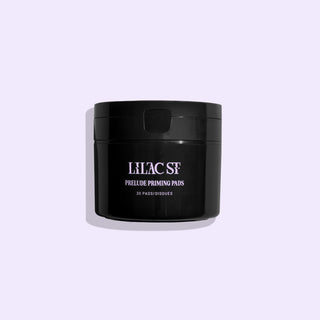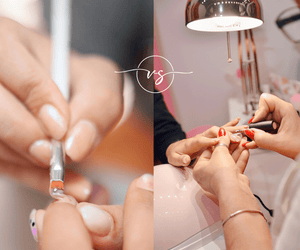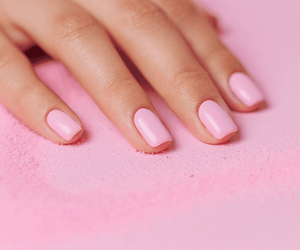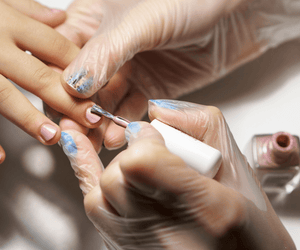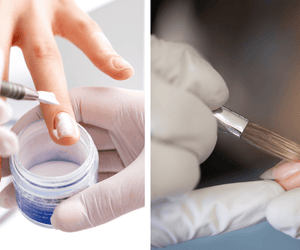Press-on nails are a budget-friendly and gentle alternative to expensive salon nail extensions. Even so, this nail enhancement isn’t totally free of complications. Experiencing “green nail” after press-ons is the most common complication, especially if your application was less-than-perfect or if you spend a lot of time interacting with water.
In this post, we’ll explain what green nail syndrome is, what causes it, and how you can treat and prevent green nails after press-ons.
Table of Contents
Understanding Green Nail Syndrome
Green nail syndrome is a mild bacterial infection, usually caused by the Pseudomonas aeruginosa bacteria. Once the bacteria colonizes an area, it produces blue and green-yellow pigments that discolor the nail, which is where the name “green nail syndrome” or “greenies” comes from.
This bacteria thrives in moist environments, so before the popularity of press-on nails and nail extensions, it was most common in people who spent a lot of time with their hands submerged in water. When water gets trapped between the press-on nail and the natural nail, this bacteria can reproduce and lead to green nail syndrome.
When this infection occurs after press-on nails or acrylics, it’s usually a minor concern, as the bacteria proliferate on the surface of the nail plate where it’s unlikely to impact surrounding tissue.
Causes of Green Nail Syndrome After Press-Ons
- Poorly fitted press-on nails with gaps or lifting that allows moisture
- Not enough glue, resulting in empty spaces between nail and press-on
- Not thoroughly drying and preparing the nails before press-on application
- Prolonged periods of submersion in water
Effective Treatments for Green Nail Syndrome
If you’re currently experiencing green nails after press-ons, rest assured that it’s usually easy to treat! Treating the underlying bacterial infection should be your priority.
The green tint on your nails will not be as easy to remove, and you may just have to wait until the nails grow out. Here are our recommendations to nip the issue in the bud as soon as possible.
Immediate Steps to Take
First, remove your press-on nails if you haven’t done so yet. While we normally recommend soaking your press-on nails in a warm water, soap, and oil bath, you may want to opt for the acetone removal method instead (just keep in mind that this method will likely melt down your nails and you won’t be able to reuse them).
Home Remedies
Treating a mild case of green nails is easy with a simple staple you probably already have at home: vinegar. A white vinegar soak will help kill the bacteria without damaging your skin. Doctors often recommend this as the first line of treatment, as prescription medications can contribute to bacterial resistance.
Mix 1 part of white vinegar with 4-10 parts water. Soak the tips of your fingers in the mixture for 10 minutes twice a day, and this will help prevent more bacterial proliferation.
After soaking your nails, make sure to dry them thoroughly. From here on out, try to keep your nails as dry as possible while still practicing basic hygiene. While the green tint of your nail may take a while to disappear, this treatment will help treat the underlying cause.
As your nails grow out, you can clip, trim, or buff away the tinted parts until all signs of “green nails” are gone.
When to Seek Professional Help
Greenies after press-on nails are usually not a cause for concern, especially if they only affect the nail plate. However, any signs of inflammation, infection under the nail plate, broken skin, or discomfort merit seeing your doctor, as a more serious nail infection can also impact surrounding tissue or result in onycholysis (i.e., the nail plate lifting).
Your doctor may prescribe topical antibacterial agents to treat the problem.
Preventing Green Nail Syndrome
It’s much easier to prevent green nails than to deal with them once they occur. Here’s what you can do to ensure your nails stay healthy and free from pseudomonas infection when wearing press-ons:
Size Your Nails Thoroughly
When measuring your press-on nails, make sure the extension fits against your nail plate completely without noticeable areas of lifting or gaps. Your press-ons shouldn’t be too small, as that can result in a tight, painful fit with lifting in the center, while too large a fit will cause the press-on to “overhang” and create an empty space where water can get underneath.
Prep Well
It’s important that you thoroughly clean and dehydrate your nails as part of your press-on nail prep. After buffing your nails for the application, use an alcohol pad to remove every last bit of moisture.
Glue Them Well
Using the right amount of glue is also a balancing act, but to prevent greenies, it’s important to use enough. Make sure the amount of glue you use covers the entire surface of your nail, but not so much that it creates too thick a layer and spills over your skin.
Rocking Motion for Better Adhesion
Once you’re ready to apply your press-ons, use a rocking motion to press the extension against your nail. This helps eliminate any air bubbles or gaps for better longevity and to ensure no water can get between your nail and the press-on.
Keeps Your Nails Dry
Wait at least two hours (and ideally overnight) before letting your nails get wet. This will allow your nail adhesive to cure completely and prevent any water from getting inside. In general, keep your nails dry as much as possible. Dry your hands immediately after washing them, and use gloves for activities that involve prolonged exposure to water, such as washing dishes or gardening.
Watch Out for Lifting or Grow-Out
If you do experience any noticeable lifting or grow-out, make sure to fix it as soon as you can. If one of your press-on nails starts lifting, take it off, remove the excess nail glue, and re-apply. If your nails are still attached, but there’s noticeable grow-out, it’s time to take them all off and re-do your manicure.
Can I Apply Press-Ons on Top of Greenies?
Don’t apply press-on nails on top of nails affected by green nail syndrome. Take at least a few weeks to treat your nails with vinegar soaks. You can use nail polish if you want to hide the discoloration. Once the discoloration has mostly disappeared or been trimmed away, you can apply press-on nails again.
Bottom Line
While getting green nails after press-on nails isn’t a big cause for concern, it’s still frustrating to deal with. The underlying bacteria is fairly easy to treat, but the green tint can stay for a long time. Once you clear away your greenies, you can get back to wearing your favorite press-on nails. Take your time to ensure a well-fitted application, and you can prevent the issue from coming back.

